Menus
Against all odds
V3 at 90 °, 499 cm3, 125 hp, 116 kg dry
Beating the Japanese factory teams by winning Grand Prix with motorcycles you yourself built in your home workshop, powered by your wife’s home cooking and freshly brewed cups of coffee in the neighboring kitchen, is a real challenge. chimerical goal that would be impossible today. But in the early 1980s, that’s exactly what engineer Alain Chevallier managed to do. His death in October 2016 at the age of 68 from cancer caused us to lose one of the great chassis designers in modern GP history..
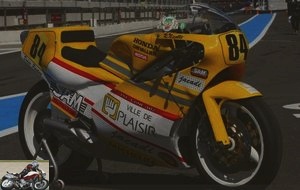 Test drive of the sporty Chevallier Honda RS500
Test drive of the sporty Chevallier Honda RS500
Genesis
When a figure as emblematic as the boss of the HRC (Honda Racing Corporation), Youichi Oguma, lent factory engines to Alain Chevallier’s small team, it was a mark of respect. It was also a response to what his motorcycles had managed to accomplish on a tight budget. It was the time when the Japanese switched to building aluminum frames, in the footsteps of Antonio Cobas. Chevallier remained faithful to the tubular steel frames. It must be said that this was not just any steel, but a cold drawn steel which, being 20% more resistant than with hot rolling, offers an increased stiffness / weight ratio, as well as a better return. for the pilot. Ducati will also follow in his footsteps later in this decade to win its world Superbike titles with tubular frame sports cars and finally, in Grand Prix with the MotoGP world title in 2007..
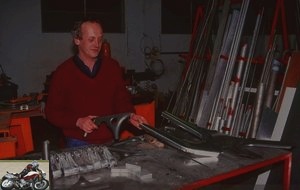 Alain Chevallier in his Vendome workshop working on the 500
Alain Chevallier in his Vendome workshop working on the 500
But Alain Chevallier did not stop there. His desire to save weight to compensate for the lack of horsepower in the engines of his motorcycles led him to be the first to install carbon disc brakes on a 500 GP. He was also the first to equip his motorcycles with dynamic air induction. He was also a pioneer in the development of fully adjustable suspensions by manufacturing his own forks and shocks. He is also the one who invested in and developed telemetry. The Chevallier workshop has been a source of unrivaled innovation.
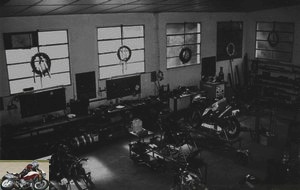 Alain Chevallier’s workshop
Alain Chevallier’s workshop
Olivier Chevallier, Alain’s younger brother, had become one of the best riders by winning the 1976 Yugoslavian Grand Prix 350 with a motorcycle prepared by Alain, who was also chief engineer of the team financed by Pernod. In 1980, the latter had also started to manufacture his own Yamaha TZ250 / 350 for Olivier. But in April he tragically died at Paul Ricard on a TZ750. Distraught, Alain was ready to turn his back on the race, before his friend Eric Saul persuaded him otherwise. Just six weeks after his brother’s death, Saul brought a Yamaha Chevallier to the French GP 350 podium for the first time at Le Castellet, managing to regain a third place at Silverstone later in the season to finish 6th in the championship.
Despite the death of his brother, Alain Chevallier therefore continued to build motorcycles. In 1982, the Belgian Didier De Radiguès led the Chevallier Yamaha 350 to victory in Yugoslavia and finished second in the championship. His teammate Eric Saul won the Austrian GP and finished 4th in the season. In 1983, now sponsored by ELF, Didier was joined in the Chevallier 250 team by Jean-François Balde who made a sensational debut by winning Kyalami for his first race on the Chevallier, just ahead of Radiguès. But Balde broke his leg in Assen and despite the satisfaction of the sponsor of the local tobacco company at the time after De Radiguès’ victory at Spa-Francorchamps, Didier only finished third in the championship behind the two Yamaha factory riders Carlos Lavado and Christian Sarron.
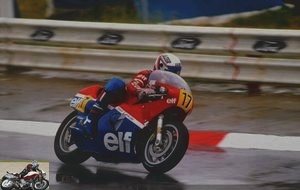 From Radigues on the Chevallier 500 to Kyalami in 1984
From Radigues on the Chevallier 500 to Kyalami in 1984
Alain Chevallier :
We had a great season with lots of pole positions and fewer crashes, but we just didn’t have enough to win the title. But for 1984 we started a new adventure.
Indeed, because with the disappearance of the 350 category and already used to racing in two grueling races in a single day, Didier de Radiguès had started a career in 500 GP on an original Honda RS500, one of the 32 customer replicas. the three-cylinder NS500 that Freddie Spencer had turned into a GP winner in 1982. But the Honda’s faulty handling was a disappointment. So in 1984, Didier convinced Alain Chevallier to switch to the premier class with a brand new motorcycle using the RS500 V3 engine, still with ELF and Johnson as a sponsor and a second motorcycle for Christian Le Liard..
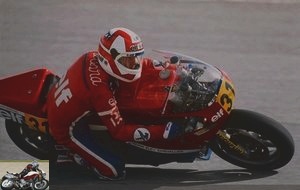 Christian le Liard during season 84
Christian le Liard during season 84
The Chevallier Honda RS500 with tubular frame is tested during a winter test at Paul Ricard by Didier who declares it good from the start. He then proved it by leading the first four laps of the first race of the season a month later in South Africa, before finishing fourth with his teammate eighth. With three other tops ten, the Belgian concludes the championship in ninth position. A satisfactory result for him and Chevallier, but curiously not for ELF who left with Serge Rosset’s team in 1985. Politics !
The redesign of the Pernod 250GP gave work to the four full-time employees of Chevallier in 1985, while the ex-Radiguès 500 was on loan to the French private Thierry Espie, who scored two points on it before returning it to Alain. . Meanwhile, the other bike, the ex-Le Liard, was tested twice by Randy Mamola who wanted to remedy the handling issues he encountered with his factory NS500. While expressing his satisfaction with the French motorcycle, he ultimately never used it in racing, although the then HRC boss allowed his teammate Takazumy Katayama to ride such a Bakker frame machine, on which Honda has reproduces the Dutch design for its 1985 MK2! She could have been a copy of Chevallier instead…
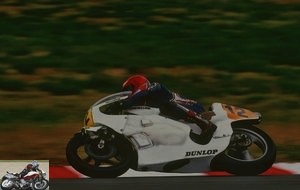 In 1985, Thierry Espie recovers the 500 as a private pilot
In 1985, Thierry Espie recovers the 500 as a private pilot
For 1986, the De Radiguès / Chevallier / RS500 trio reformed under the sonsporing of Rollstar, which resulted in an even more successful season with eight top 10s in 12 races and a seventh place in the championship. It was above all the best Honda three-cylinder, two places ahead of Ron Haslam on Rosset’s ELF 3! The year was especially marked by this magnificent second place won in the pouring rain by De Radiguès at Silverstone, only 9 seconds behind Wayne Gardner’s NSR500 V4 and ahead of all the other factory four cylinders, including the Yamaha of the future. champion Eddie Lawson.
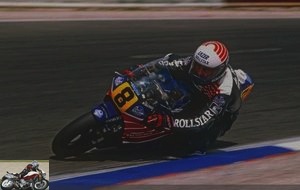 De Radiguиs during the 1986 French GP at Paul Ricard
De Radiguиs during the 1986 French GP at Paul Ricard
In 1987, de Radiguès was hired by Cagiva with Chevallier as chassis consultant, allowing the Italian manufacturer to sign its best result to date with a 4th place in Brazil. But tensions within the team see Alain completely turning away from the Grands Prix, despite the offer of factory Honda engines from Oguma-san that he had to refuse, without a team to run the V4 Chevallier Honda. He then began to work for Sonauto Yamaha in order to develop their Paris-Dakar motorcycles and for Yamaha on the project of the steering hub GTS which would make its debut in 1993. A year later, he began a new job as director technique of the young French brand Voxan whose owner Jacques Gardette wanted him to develop the framework and supervise the technical development of the motorcycles. But this is another story…
Discovery
Only three Honda RS500 Chevalliers were built: the original de Radiguès Johnson motorcycle from 1984, the Le Liard / ELF copy of the same season and the Rollstar from 1986, built new with modified chassis geometry and the possibility of adjust the latter.
 Only three Honda RS500 Chevalliers were built
Only three Honda RS500 Chevalliers were built
The original 1984 Johnson was kept as a spare motorcycle in 1986, but was sold by Chevallier in 88 to private rider Rachel Nicotte who won the national title in that year in 500, winning most races with her motorcycle in the colors of the Jacadi children’s clothing brand. This season and the next, Nicotte also participated in several Grand Prix 500 and the European Championship where he finished second..
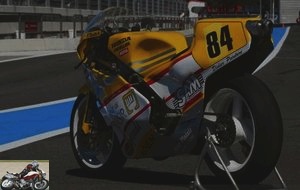 The original model was then used by Rachel Nicotte
The original model was then used by Rachel Nicotte
The late Olivier ‘Gull’ Rietsch, who died in February 2020, had been the coordinator of the small Chevallier Honda 500GP team of Nicotte. He kept the ex-De Radiguès, ex-Espie, ex-Nicotte after Rachel’s death in 2005. The motorcycle still sports the colors of the town of Plaisir, where Gull and Rachel lived and whose mayor was a motorcycle fan..
I gave up my job in property maintenance to go racing with Rachel in 1988. I did anything that didn’t involve working on the bike or riding it, that is, driving the bike. truck, feed us, buy fuel, parts, supplies, tires and most of all fix the fairing – Rachel used to fall a lot. I mean – A LOT !! We mined it with very few resources because we had no money for parts. We befriended one of the Honda mechanics and he said, "At exactly 9pm tonight I’m going to throw our used parts in that trash over there." So we made sure to wait around the corner. Their definition of wear was just fine for us !
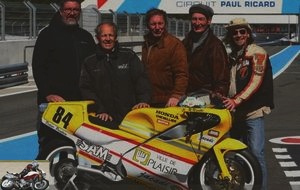 Olivier Rietsch (left) and his team have restored the RS
Olivier Rietsch (left) and his team have restored the RS
When Nicotte stopped riding the Chevallier, he gave it to Gull to keep it, until the latter finally bought him the bike. Nicotte’s tragic death then prompted Gull to rebuild the bike to make it race again in historic events like the Bikers Classic at Spa. It was also there, in 2014, that we found ourselves sharing the same box and … well, you can easily guess the rest.
 The Chevallier Honda RS500 gets naked
The Chevallier Honda RS500 gets naked
I still had to wait five years for my promised test to materialize, while Gull managed to find new pistons for the Honda V3. A batch produced by Tech 3 Classic allowed Emmanuel Laurentz to rebuild the engine, while Yves Kerlo undertook a restoration of the frame, which was completed just two weeks before the Sunday Ride Classic, at Paul Ricard. There, in the first two sessions, I found myself breaking in the restored engine with Freddie Spencer, Kevin Schwantz, Giacomo Agostini and his son Giacomino and Christian Sarron passing me as I took it slow. Yes, that was my excuse, anyway…
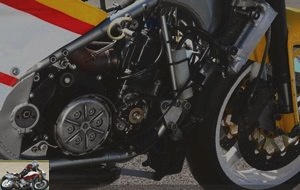 The pistons of the Honda V-three were all changed just before taxiing
The pistons of the Honda V-three were all changed just before taxiing
The Johnson Chevallier features a typical Alain Chevallier cold-drawn tubular steel double-cradle frame, with massive reinforcement around the steering column. Even so, it weighs just over 5kg, minus the chrome-molybdenum steel tubular swingarm with fully adjustable WP mono-shock. The fully adjustable 40mm Chevallier inverted fork is set for 23 ° stiffer trail than the 24 ° 5 ‘of the stock Honda while the wheelbase is much longer at 1,420mm versus 1,375mm for the RS 500 , probably for better stability.
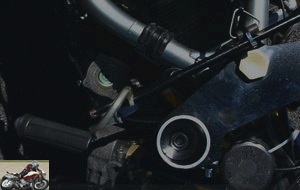 The Chevallier inverted fork is fully adjustable
The Chevallier inverted fork is fully adjustable
However, instead of the only carbon front disc that de Radiguès raced with in 1984, today we find a pair of AP-Lockheed 310mm steel discs fitted with 4-piston calipers. This is because Thierry Espie rode them when he borrowed the bike in 1985 and he did not have the means to replace regularly worn carbon discs. In return, the bike weighs today 116 kg against the 111 kg of 1984, but with a weight bias towards the front of 52/48% and the carburettors at the front. This solution which solved the problems of insufficient weight on the front wheel that the original RS500 knew.
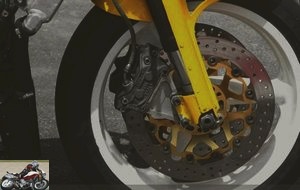 Unlike the original carbon, the Chevallier is now equipped with steel discs
Unlike the original carbon, the Chevallier is now equipped with steel discs
Test
You immediately realize how "small" the Chevallier is when you pilot it. Compared to the dozen or so Honda NS / RS500s I’ve had the chance to ride over the years, this one looks more like a 350 than a 500. In fact, Rachel Nicotte was much shorter than me. So I found the close riding position far too cramped to feel comfortable on the bike. I couldn’t move easily in the saddle and it was impossible to hide behind the bubble. It’s a shame, because Didier de Radiguès and I are the same size and it would have been nice to try it under its configuration. But it also gives a very good idea of the liveliness of the bike in its way of changing direction so easily in the many chicanes of the Paul Ricard without having to slow down..
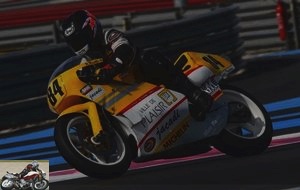 Very compact, the motorcycle is closer to the agility of a 350
Very compact, the motorcycle is closer to the agility of a 350
The Chevallier remains very stable in fast curves, like the one to the right of Les Signes, which is approached in fourth when exiting the straight line of the Mistral and where the long wheelbase surely comes into play to compensate for the very closed geometry of the steering. . The steering is not nervous or jerky, but very stable and offering a lot of serenity.
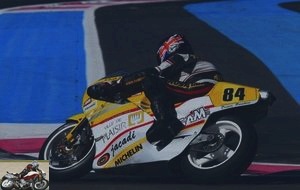 However, the Honda Chevallier remains very stable in fast curves.
However, the Honda Chevallier remains very stable in fast curves.
The bike also brakes well, its lightness is surely a key factor, as I saw during this fascinating "battle" against Eric Beurlys on a stock RS500 during the main event on Sunday. Thanks to its light weight and the highly efficient AP-Lockheed brake set, the Chevallier can gain many meters when braking in chicanes or later after Signes. But then he accelerated harder than me out of the corner and caught up with the gap when I was capped at 11,000 rpm while the new Tech3 pistons were broken in. This is when the Honda engine really takes off, after sharper acceleration from 9,500 rpm, but without the ATAC valves which were subsequently installed on the Honda three cylinders to achieve a smoother response..
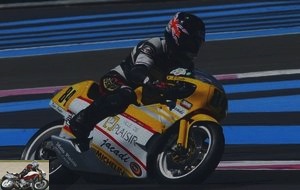 The lightness of the machine allows late braking
The lightness of the machine allows late braking
On my last four laps, I cranked up the revs to 11,800rpm and saw a huge difference in the acceleration of the Honda, while making it even easier to drive. This is because I now shift gears when I need to always staying in the power range instead of having to play with the clutch. This higher torque also did not upset the balance of the Chevallier’s frame or its ease of handling..
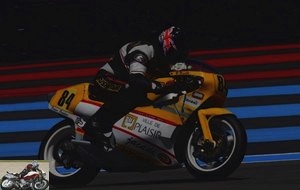 I had to wait a bit before I could push the engine into the towers
I had to wait a bit before I could push the engine into the towers
Conclusion
What a nice little bike – well, with 125 horsepower delivered at 11,500 rpm, you could say that this one is boxing in the top category..
The only regret is that Alain Chevallier is no longer with us. He was therefore unable to admire the wonderful work that Gull & Co. did in restoring the first Chevallier Honda 500. And if Olivier Rietsch is now gone too, I am convinced that seeing and hearing the bike he was riding on again. devoted so much of his life must have given him great satisfaction. Farewell, Gull and thank you for the ride !
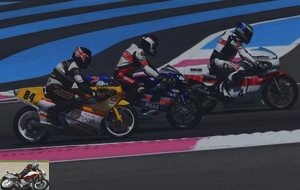 Driving at Paul Ricard with the old Cecotto TZ750 and the Yamaha Tech-3 Classic
Driving at Paul Ricard with the old Cecotto TZ750 and the Yamaha Tech-3 Classic
Strong points
- Motor
- Agility
- Stability
- Braking
Weak points
- For small sizes
The technical sheet of the Chevallier Honda RS500
Related articles
-
The Japanese endurance Bimota based on Honda CBR900RR Fireblade 4 cylinders in line, 944 cm3, 177 hp, 163 kg TSR Honda AC90M. Who does this name mean?…
-
The European Grand Prix prototype 108 ° V4, 499 cc, 192 hp at 12,500 rpm, 129 kg We find it normal to see Ducati, KTM and Aprilia currently competing in…
-
497 cc, 82 hp, 190 km / h, the first mass-produced turbo motorcycle A Power Ranger look for an expensive but efficient grand tourer The turbo , it’s a…
-
Honda CMX 500 Rebel S motorcycle test
Little rebellious bobber In-line twin, 471 cm3, 45 hp at 8,500 rpm, 44.6 Nm at 6,000 rpm, 190 kilos, € 6,299 Rather bi or 4? It’s that the couple is…
-
Dick Mann’s motorcycle victorious at the 1971 Daytona 200 The 200 miles of Daytona are one of the legendary races where talented riders on the handlebars…
-
The last of the line The ultimate expression of ELF’s motorcycle design philosophy was the ELF5 , itself an evolution of the unsuccessful ELF4 and which…
-
Honda CBR 600 RR motorcycle test
1700 km test The CBR 600 RR is the Honda hypersport, the ultimate weapon of the Hamamatsu firm, whose lineage with the RC211V is evident. The 2010…
-
Offenstadt Kawasaki 750 sports bike test
The H2 Monocoque Pilot-engineers are a rare breed, especially those who are equally expert in both disciplines and able to design innovative and unique…
-
Moto Guzzi 500 Bicilindrica sports test
The Methuselah of motorcycle racing 120 ° V-twin, 494 cc, 52 hp, 145 kg Birthday ! Moto Guzzi celebrates its 100th anniversary this year! In contrast to…
-
One of a kind V-Twin demodue, 904 cm3, 75 hp and 76 Nm, 186 kg dry, 2,000 copies produced You know you’ve been successful as a motorcycle designer when…